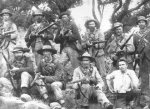L
longguntoter
Guest
I would have to agree here, due to the fact that these two round's history is still being used on today's battlefields. I would have to say the next step will be caseless ammo, which is still in the testing/limited use stages right now. JMHO.The 8mm Lebel, or the 7.92x33mm. I think you could make a case for either of these.
The 8mm Lebel as it ushered in the era of smokeless propellants, an event I think most of us would agree was world-altering. It made virtually every army still using black powder obsolete, and caused a massive rearmament program for all to meet the new threat. It also allowed the greatest developments in firearms design, as the negatives of black powder was what prevented the development of better action types such as gas operated autoloaders and machineguns. The greater power afforded by this propellant increased velocity and range to what we're still seeing today, which in turn spurred the development of better bullets, etc..
The 7.92x33mm marked a sea change in cartridge design, intended to address the range limitations of modern (1940s and beyond) combat. Intended to allow the infantryman to carry greater amounts of ammo and increase his personal firepower, while still being lethal at typical combat ranges, it got away from the excessively powerful rounds like the 30-06, 8x57mm and the 7.62x54R. The rest of the world saw the advantages and copied the concept, if not always the design itself. This is what gave us the 7.62x39mm M43 and the NATO 5.56mm rounds. Important changes, all going back to recognizing the changing nature of combat from the Napoleanic tactics still lingering when most of the other cartridges I mentioned were developed.


